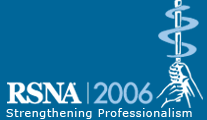
Abstract Archives of the RSNA, 2006
Heinz L Voit MD, Presenter: Nothing to Disclose
Bernhard Krauss PhD, Abstract Co-Author: Employee, Siemens AG
Arno Dimmler MD, Abstract Co-Author: Nothing to Disclose
Boris Adamietz, Abstract Co-Author: Nothing to Disclose
Katharina Anders MD, Abstract Co-Author: Nothing to Disclose
Axel Kuettner MD, Abstract Co-Author: Nothing to Disclose
Standard treatment for symptomatic and non-symptomatic cholecystolithiasis is cholecystectomy. Non-invasive approaches such as oral litholysis are mainly limited to patient with pure cholesterol stones, which often is difficult to assess when using either ultrasound or conventional CT. This study examines the possibility of a novel clinically available dual-source CT using two tubes mounted in the gantry applying dual energy technique to non-invasively characterize gallstones in vitro (DECT).
Pathology provided 40 randomly selected gallstones excised during cholecystectomy. They were individually embedded in ultrasound gel. Scanner settings were: 2 x 64 slices per rotation, collimation 0.6 mm, tube 1: 80 kV, 175 mAs and tube 2: 140 kV, 170 mAs. Pitch 1.4, reconstruction slice with 1.0 mm, recon increment 1.0 mm. For comparison scans were repeated using the same scanner setting using monoenergetic scans at either 80 kV as well as 140 kV. Dual energy analysis was performed image based. Gold standard was pathological classification.
Pathological analysis revealed 7 calcified stones, 15 pigmented stones, 7 pure cholesterol stones 6 mixed cholesterol stones and 5 mixed pigmented stones. Dual energy analysis was able to distinctively differentiate between all subtypes. Moreover DECT was able to differentiate between two different subtypes of cholesterol. One subgroup had 4 cholesterol stones that were not visible in conventional 140kV monoenergetic CT and had a lesser density. Pathology differentiated these types by surface analysis. The non-visible group had a smooth surface whereas the other group had a structured surface. This other group was visible at both energy levels.
These primary results indicate that DECT permits subtle characterization of gallstones in vitro using a clinically available dual source CT. It also allows for detection of primarily non radio opaque cholesterol stones at 140kV, an energy level often used for obese patients.
Reliable detection and characterization of cholesterol stones could permit better treatment decision for obese patients at elevated risk during surgery, whether to undergo oral litholysis or surgery.
Voit, H,
Krauss, B,
Dimmler, A,
Adamietz, B,
Anders, K,
Kuettner, A,
Dual-source CT Characterization of Gallstones Using a Dual-Energy Analysis. Radiological Society of North America 2006 Scientific Assembly and Annual Meeting, November 26 - December 1, 2006 ,Chicago IL.
http://archive.rsna.org/2006/4431954.html

